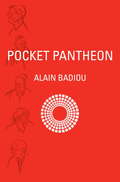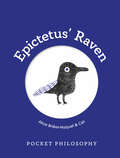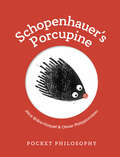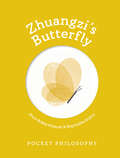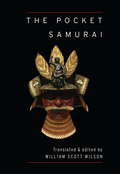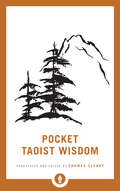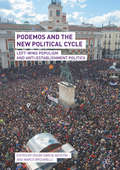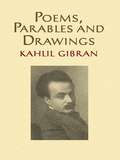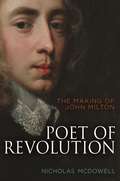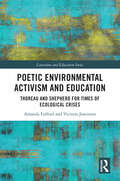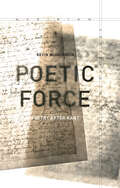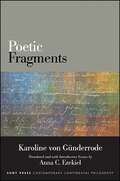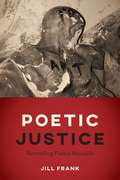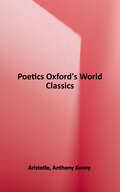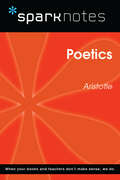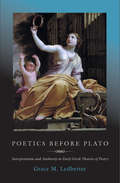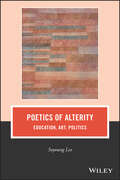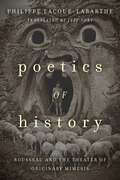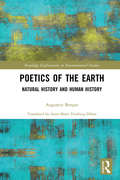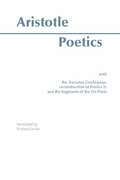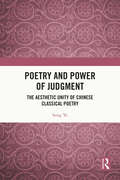- Table View
- List View
Pocket Pantheon: Figures of Postwar Philosophy
by David Macey Alain BadiouPocket Pantheon is an invitation to engage with the greats of postwar Western thought, such as Lacan, Sartre and Foucault, in the company of one of today's leading political and philosophical minds. Alain Badiou draws on his encounters with this pantheon--his teachers, opponents and allies--to offer unique insights into both the authors and their work. These studies form an accessible, authoritative distillation of continental theory and a capsule history of a period in Western thought.From the Trade Paperback edition.
Pocket Philosophy: Epictetus' Raven
by Alice Brière-HaquetEpictetus (c. 50-c. 135 AD) was a Greek Stoic philosopher. He believed that philosophy should be a way of life and not just a theoretical study. In this story, Epictetus is reminding us to focus only on what we can control – our own actions – and not spend time worrying about what we can't control. Happiness can only be achieved when we accept what we can't control and adopt the most positive outlook we can.By adapting famous animal parables, the Pocket Philosophy series seeks to introduce inquisitive readers of all ages – from 1 to 100! – to the biggest names in philosophy.
Pocket Philosophy: Heidegger's Lizard
by Alice Brière-HaquetMartin Heidegger (1889-1976) is one of the most influential – and controversial – philosophers of the twentieth century. He is mostly associated with existentialism (the study of human experience) and phenomenology (the study of consciousness), and his work was enormously influential.In this story, Heidegger is exploring the relationship between 'beings' and their environments. How much does each – the rock, the lizard and the human – understand of the world around them?By adapting famous animal parables, the Pocket Philosophy series seeks to introduce inquisitive readers of all ages – from 1 to 100! – to the biggest names in philosophy.
Pocket Philosophy: Schopenhauer's Porcupine
by Alice Brière-HaquetArthur Schopenhauer (1788-1860) was a German philosopher and a proponent of pessimistic philosophy. Deeply cynical of love and the want for children, he believed humans are all mere animals – just far more unhappy, because of our self-awareness.The porcupine dilemma is a metaphor about the challenges of human intimacy. Schopenhauer believed that, despite our good intentions, human intimacy cannot occur without substantial harm.By adapting famous animal parables, the Pocket Philosophy series seeks to introduce inquisitive readers of all ages – from 1 to 100! – to the biggest names in philosophy.
Pocket Philosophy: Zhuangzi's Butterfly
by Alice Brière-HaquetZhuangzi (late 4th century BC) was one of China's most significant proponents of Daoism. Daoism is an ancient philosophy that strives for harmony with nature, virtuousness and self-development. Zhuangzi's story of the dreaming philosopher and the butterfly is meant to challenge us to think about one big question: how do we really know what's real?By adapting famous animal parables, the Pocket Philosophy series seeks to introduce inquisitive readers of all ages – from 1 to 100! – to the biggest names in philosophy.
Pocket Samurai
by William Scott WilsonSelected writings from the most influential texts of the samurai era--in a pocket-size edition. The samurai of Japan, who were the country's military elite from medieval times to the end of the nineteenth century, were synonmous with valor, honor, and martial arts prowess. Their strict adherence to the code of bushido ("the way of the warrior"), chivalry, and honor in fighting to the death continues to capture the imagination of people today, inspiring authors, filmmakers, and artists. The Pocket Samurai contains the essential writings of the era by the most esteemed samurai and philosophers of the age, including the iconic Miyamoto Musashi, author of The Book of Five Rings; Yamamoto Tsunetomo, author of Hagakure, the best-known explication of the samurai code; Takuan Soho, the Zen priest and adviser to samurai; Yagyu Munenori, whose The Life-Giving Sword describes a deeply spiritual approach to sword fighting; and others.
Pocket Taoist Wisdom (Shambhala Pocket Library)
by Thomas ClearyThis compact collection of Taoism's greatest masterpieces introduces its most fundamental teachings and reveals the essential spirit of Tao.From the time of its earliest sages in prehistoric China, Taoism has looked to the underlying Way of all things (the Tao) as a guide to thoughts and actions. For the Taoists, the patterns of nature revealed the answers to their deepest spiritual questions and provided the inspiration for their unique teachings. Over the centuries, Taoism has blossomed into a profound tradition with a variety of forms--all united by a single, core philosophy of radical simplicity and natural living. Today, Taoism is most widely known through the Tao-te Ching, yet its corpus of literature is vast--ranging from philosophical dialogues and essays to astonishing fables, legends, proverbs, and more.This volume includes: Tao-te Ching: The foundational source of Taoist thought by the legendary Lao TzuChuang-tzu: Philosophical dialogues from one of Taoism's most famous sagesHuai-nan-tzu: Teachings from the time of the Han dynasty on affairs of state, natural science, and Taoist psychologyWen-tzu: Records of further sayings by Lao Tzu on the art of livingTales of Inner Meaning: Fables, stories, and jokes from the Lieh-tzu and others on the subtleties of Taoist philosophySayings of Ancestor Lu: Teachings from Lu Yen, a seminal figure in the founding of the Complete Reality school of Taoism and master synthesizer of China's classic spiritual traditions
Podcasting (Digital Media and Society)
by Jeremy Wade MorrisPodcasting burst onto the media landscape in the early 2000s. At the time, there were hopes it might usher in a new wave of amateur and professional cultural production and represent an alternate model for how to produce, share, circulate and experience new voices and perspectives. Twenty years later, podcasting is at a critical juncture in its young history: a moment where the early ideals of open standards and platform-neutral distribution are giving way to services that prioritize lean-back listening and monetizable media experiences. This book provides an accessible and comprehensive account of one of digital media’s most vibrant formats. Focusing on the historical changes shaping podcasts as a media format, the book explores the industrial, technological and cultural components of podcasting alongside case studies of various podcasts, industry publications, and streaming audio platforms (e.g. Spotify, Google and Apple Podcasts). Jeremy Morris argues that as streaming platforms push to make podcasting more industrialized, accessible, user-friendly and similar to other audio media like music or audiobooks, they threaten podcasting’s early, though always unrealized, promises. This is the go-to introduction for students and researchers of media, communication and cultural studies, as well as readers who enjoy making and listening to podcasts.
Podemos and the New Political Cycle
by Óscar García Agustín Marco BriziarelliThis edited volume explores the context in which the Spanish party Podemos operates as both an agent and product of political cycles. It provides an account of the party's genealogy, ideological environment and relation to other political initiatives in Latin America and Western Europe. The contributors address the multiples dynamics generated by Podemos as a new party developed out of the economic crisis, the structural crisis concerning social democracy and the incarnation of the welfare state project, and, more generally, out of the Left. It will appeal to upper-level students and scholars interested in Spanish politics, history, culture and sociology.
Poems, Parables and Drawings
by Kahlil Gibran Alice RaphaelThe perfect companion to Kahlil Gibran's classic, The Prophet, this elegant volume presents an original selection of works by the popular writer and artist. It consists of the complete texts and drawings of The Madman and The Forerunner, plus 20 additional illustrations--many long out of print--and a perceptive essay by art historian Alice Raphael. The Madman features a series of concise stories and verses offering uplifting views of human nature. Gibran warmly encourages his readers to abandon the superficial and embrace the true self, an outlook that recurs in The Forerunner and its 24 morality tales. Each of the poems, parables, and illustrations reflects Gibran's fervent belief in the transformative powers of love. This splendid keepsake edition of the renowned author's influential works is an ideal gift for any occasion.
Poet of Revolution: The Making of John Milton
by Nicholas McDowellA groundbreaking biography of Milton’s formative years that provides a new account of the poet’s political radicalizationJohn Milton (1608–1674) has a unique claim on literary and intellectual history as the author of both Paradise Lost, the greatest narrative poem in English, and prose defences of the execution of Charles I that influenced the French and American revolutions. Tracing Milton’s literary, intellectual, and political development with unprecedented depth and understanding, Poet of Revolution is an unmatched biographical account of the formation of the mind that would go on to create Paradise Lost—but would first justify the killing of a king.Biographers of Milton have always struggled to explain how the young poet became a notorious defender of regicide and other radical ideas such as freedom of the press, religious toleration, and republicanism. In this groundbreaking intellectual biography of Milton’s formative years, Nicholas McDowell draws on recent archival discoveries to reconcile at last the poet and polemicist. He charts Milton’s development from his earliest days as a London schoolboy, through his university life and travels in Italy, to his emergence as a public writer during the English Civil War. At the same time, McDowell presents fresh, richly contextual readings of Milton’s best-known works from this period, including the “Nativity Ode,” “L’Allegro” and “Il Penseroso,” Comus, and “Lycidas.”Challenging biographers who claim that Milton was always a secret radical, Poet of Revolution shows how the events that provoked civil war in England combined with Milton’s astonishing programme of self-education to instil the beliefs that would shape not only his political prose but also his later epic masterpiece.
Poetic Environmental Activism and Education: Thoreau and Shepherd for Times of Ecological Crises (Literature and Education)
by Amanda Fulford Victoria JamiesonThis book brings together the works of the nineteenth and twentieth century writers Henry David Thoreau and Anna Shepherd. Finding in their work a common approach of poetic forms of writing that enact kinds of environmental activism, the book re-positions them in the context of current environmental crises by offering an original resource for supporting poetic environmental activism in educational contexts.Bringing together scholarship from North America and Europe, the book draws on Thoreau and Shepherd’s literary and philosophical sources to support a conceptual understanding of education’s role in how we think about, understand, and tackle the climate crisis. Chapters trace the idea of poetic environmental activism in Thoreau and Shepherd, applying literary and environmental thought to educational practice and contexts. The book is timely in taking a scholarly approach that explores educational engagements with climate change and focuses on education for environmental sustainability.Advocating for engagement with the climate emergency through the lens of poetic environmental activism, this volume will appeal to postgraduate students, researchers, and scholars involved with sustainability education, philosophy of education, poetic inquiry, and literary theory for environmental action.
Poetic Force: Poetry After Kant
by Kevin MclaughlinThis book argues that the theory of force elaborated in Immanuel Kant's aesthetics (and in particular, his theorization of the dynamic sublime) is of decisive importance to poetry in the nineteenth century and to the connection between poetry and philosophy over the last two centuries. Inspired by his deep engagement with the critical theory of Walter Benjamin, who especially developed this Kantian strain of thinking, Kevin McLaughlin uses this theory of force to illuminate the work of three of the most influential nineteenth-century writers in their respective national traditions: Friedrich Hölderlin, Charles Baudelaire, and Matthew Arnold. The result is a fine elucidation of Kantian theory and a fresh account of poetic language and its aesthetic, ethical, and political possibilities.
Poetic Fragments (SUNY series in Contemporary Continental Philosophy)
by Karoline von GünderrodeThe second collection of writings by the German poet, dramatist, and philosopher Karoline von Günderrode (1780–1806), Poetic Fragments was published in 1805 under the pseudonym "Tian." Günderrode's work is an unmined source of insight into German Romanticism and Idealism, as well as into the reception of Indian, Persian, and Islamic thought in Europe. Anna C. Ezekiel's introductions highlight the philosophical significance of the texts, demonstrating their radical and original consideration of the nature of the universe, death, religion, power, and gender roles. The dramas "Hildgund" and "Muhammad, the Prophet of Mecca" are two of Günderrode's most important works for her accounts of agency, recognition, and the status of women. The three poems included in the collection, "Piedro," "The Pilgrims," and "The Kiss in the Dream," represent the wide range of forms in which Günderrode wrote. They reflect themes of erotic longing and union with the divine, and point to her radical reimagining of death. This bilingual English-German edition is the first volume of Günderrode's work to appear in English, and will help unearth this rich, complex, and innovative writer for English readers.
Poetic Justice: Rereading Plato's "Republic"
by Jill FrankWhen Plato set his dialogs, written texts were disseminated primarily by performance and recitation. He wrote them, however, when literacy was expanding. Jill Frank argues that there are unique insights to be gained from appreciating Plato’s dialogs as written texts to be read and reread. At the center of these insights are two distinct ways of learning to read in the dialogs. One approach that appears in the Statesman, Sophist, and Protagoras, treats learning to read as a top-down affair, in which authoritative teachers lead students to true beliefs. Another, recommended by Socrates, encourages trial and error and the formation of beliefs based on students’ own fallible experiences. In all of these dialogs, learning to read is likened to coming to know or understand something. Given Plato’s repeated presentation of the analogy between reading and coming to know, what can these two approaches tell us about his dialogs’ representations of philosophy and politics? With Poetic Justice, Jill Frank overturns the conventional view that the Republic endorses a hierarchical ascent to knowledge and the authoritarian politics associated with that philosophy. When learning to read is understood as the passive absorption of a teacher’s beliefs, this reflects the account of Platonic philosophy as authoritative knowledge wielded by philosopher kings who ruled the ideal city. When we learn to read by way of the method Socrates introduces in the Republic, Frank argues, we are offered an education in ethical and political self-governance, one that prompts citizens to challenge all claims to authority, including those of philosophy.
Poetic Logic and the Origins of the Mathematical Imagination (Mathematics in Mind)
by Marcel DanesiThis book treats eighteenth-century Italian philosopher Giambattista Vico’s theory of poetic logic for the first time as the originating force in mathematics, transforming instinctive counting and spatial perception into poetic (metaphorical) symbolism that dovetails with the origin of language. It looks at current work on mathematical cognition (from Lakoff and Núñez to Butterworth, Dehaene, and beyond), matching it against the poetic logic paradigm. In a sense, it continues from where Kasner and Newman left off, connecting contemporary research on the mathematical mind to the idea that the products of early mathematics were virtually identical to the first forms of poetic language. As such, this book informs the current research on mathematical cognition from a different angle, by looking back at a still relatively unknown philosopher within mathematics.The aim of this volume is to look broadly at what constitutes the mathematical mind through the Vichian lens of poetic logic. Vico was among the first to suggest that the essential nature of mind could be unraveled indirectly by reconstructing the sources of its “modifications” (his term for “creations”); that is, by examining the creation and function of symbols, words, and all the other uniquely human artifacts—including mathematics—the mind has allowed humans to establish “the world of civil society,” Vico’s term for culture and civilization.The book is of interest to cognitive scientists working on math cognition. It presents the theory of poetic logic as Vico articulated it in his book The New Science, examining its main premises and then applying it to an interpretation of the ongoing work in math cognition. It will also be of interest to the general public, since it presents a history of early mathematics through the lens of an idea that has borne fruit in understanding the origin of language and symbols more broadly.
Poetics
by Aristotle Joe SachsA complete translation of Aristotle's classic that is both faithful and readable, along with an introduction that provides the modern reader with a means of understanding this seminal work and its impact on our culture. In this volume, Joe Sachs (translator of Aristotle's Physics, Metaphysics, and the Nicomachean Ethics )also supplements his excellent translation with well-chosen notes and glossary of important terms.Focus Philosophical Library translations are close to and are non-interpretative of the original text, with the notes and a glossary intending to provide the reader with some sense of the terms and the concepts as they were understood by Aristotle's immediate audience.
Poetics (Oxford World's Classics Ser.)
by AristotleAristotle's Poetics is the most influential book on poetry ever written. A founding text of European aesthetics and literary criticism, from it stems much of our modern understanding of the creation and impact of imaginative writing, including poetry, drama, and fiction. <p><p>For Aristotle, the art of representation conveys universal truths that we can appreciate more easily than the lessons of history or philosophy. In his short treatise Aristotle discusses the origins of poetry and its early development, the nature of tragedy and plot, and offers practical advice to playwrights. <p><p>This new translation by Anthony Kenny is accompanied by associated material from Plato and a range of responses from more modern literary practitioners: Sir Philip Sidney, P. B. Shelley, and Dorothy L. Sayers. The book includes a wide-ranging introduction and notes, making this the most accessible and attractive modern edition.
Poetics (SparkNotes Philosophy Guide)
by SparkNotesPoetics (SparkNotes Philosophy Guide) Making the reading experience fun! SparkNotes Philosophy Guides are one-stop guides to the great works of philosophy–masterpieces that stand at the foundations of Western thought. Inside each Philosophy Guide you&’ll find insightful overviews of great philosophical works of the Western world.
Poetics before Plato: Interpretation and Authority in Early Greek Theories of Poetry
by Grace M. LedbetterCombining literary and philosophical analysis, this study defends an utterly innovative reading of the early history of poetics. It is the first to argue that there is a distinctively Socratic view of poetry and the first to connect the Socratic view of poetry with earlier literary tradition. Literary theory is usually said to begin with Plato's famous critique of poetry in the Republic. Grace Ledbetter challenges this entrenched assumption by arguing that Plato's earlier dialogues Ion, Protagoras, and Apology introduce a distinctively Socratic theory of poetry that responds polemically to traditional poets as rival theorists. Ledbetter tracks the sources of this Socratic response by introducing separate readings of the poetics implicit in the poetry of Homer, Hesiod, and Pindar. Examining these poets' theories from a new angle that uncovers their literary, rhetorical, and political aims, she demonstrates their decisive influence on Socratic thinking about poetry. The Socratic poetics Ledbetter elucidates focuses not on censorship, but on the interpretation of poetry as a source of moral wisdom. This philosophical approach to interpreting poetry stands at odds with the poets' own theories--and with the Sophists' treatment of poetry. Unlike the Republic's focus on exposing and banishing poetry's irrational and unavoidably corrupting influence, Socrates' theory includes poetry as subject matter for philosophical inquiry within an examined life. Reaching back into what has too long been considered literary theory's prehistory, Ledbetter advances arguments that will redefine how classicists, philosophers, and literary theorists think about Plato's poetics.
Poetics of Alterity: Education, Art, Politics (Journal of Philosophy of Education)
by Soyoung LeePOETICS OF ALTERITY Education today is commonly oriented towards citizenship and skills for life, with aims of happiness and wellbeing. But this benign image harbours surreptitious forms of control, which ultimately undermine the goods it professes to safeguard and stifle education’s very purpose. What release can there be from these constrictions? Release is to be found, as Soyoung Lee eloquently shows, by attending to elements of experience that seem to escape our grip, from challenging aspects of our moral lives to struggles over practicalities of curriculum content. The more robust, more outward-turning orientation she demonstrates emphasises engagement with subject-matter, with problems and forms of narrative, that defy pre-determined formulations and categories. This requires turning towards objects worthy of attention and towards people and their claims on us. The arts and the humanities have special importance as spaces where alterity presents and expresses itself. Lee’s dialogue with Heidegger, Levinas, Derrida, and Celan shows how acknowledgement of the other must condition not only practices of teaching and learning but practicalities of our social and political lives. Attending to anxieties inherent in teaching and learning, in school and the wider world, the book’s powerful rationale for the curriculum provides nothing less than a new grounding for the humanities.
Poetics of History: Rousseau and the Theater of Originary Mimesis
by Philippe Lacoue-LabartheRousseau’s opposition to the theater is well known: Far from purging the passions, it serves only to exacerbate them, and to render them hypocritical. But is it possible that Rousseau’s texts reveal a different conception of theatrical imitation, a more originary form of mimesis? Over and against Heidegger’s dismissal of Rousseau in the 1930s, and in the wake of classic readings by Jacques Derrida and Jean Starobinski, Lacoue-Labarthe asserts the deeply philosophical importance of Rousseau as a thinker who, without formalizing it as such, established a dialectical logic that would determine the future of philosophy: an originary theatricality arising from a dialectic between “nature” and its supplements.Beginning with a reading of Rousseau’s Discourse on Inequality, Lacoue-Labarthe brings out this dialectic in properly philosophical terms, revealing nothing less than a transcendental thinking of origins. For Rousseau, the origin has the form of a “scene”—that is, of theater. On this basis, Rousseau’s texts on the theater, especially the Letter to d’Alembert, emerge as an incisive interrogation of Aristotle’s Poetics. This can be read not in the false and conventional interpretation of this text that Rousseau had inherited, but rather in relation to its fundamental concepts, mimesis and katharsis, and in Rousseau’s interpretation of Greek theater itself. If for Rousseau mimesis is originary, a transcendental structure, katharsis is in turn the basis of a dialectical movement, an Aufhebung that will translate the word itself (for, as Lacoue-Labarthe reminds us, Aufheben translates katharein). By reversing the facilities of the Platonic critique, Rousseau inaugurates what we could call the philosophical theater of the future.
Poetics of the Earth: Natural History and Human History (Routledge Explorations in Environmental Studies)
by Augustin BerquePoetics of the Earth is a work of environmental philosophy, based on a synthesis of eastern and western thought on natural and human history. It draws on recent biological research to show how the processes of evolution and history both function according to the same principles. Augustin Berque rejects the separation of nature and culture which he believes lies at the root of the environmental crisis. This book proposes a three stage process of "re-worlding" (moving away from the individualized self to become a part of the common world), "re-concretizing" (understanding the meaning and historical development of words and things) and "re-engaging" (reconsidering the relationship between history and subjectivity at every level of being) in order to bring western thought on nature and culture into sustainable harmony and alignment. This book will be of great interest to students and scholars of environmental studies, environmental philosophy, Asian studies and the natural sciences.
Poetics: with the Tractatus Coislinianus, reconstruction of Poetics II, and the fragments of the On Poets
by Aristotle Richard JankoRichard Janko's acclaimed translation of Aristotle's Poetics is accompanied by the most comprehensive commentary available in English that does not presume knowledge of the original Greek. Two other unique features are Janko's translations with notes of both the Tractatus Coislinianus, which is argued to be a summary of the lost second book of the Poetics, and fragments of Aristotle's dialogue On Poets, including recently discovered texts about catharsis, which appear in English for the first time.
Poetry and Power of Judgment: The Aesthetic Unity of Chinese Classical Poetry
by Song YeThis book examines Chinese traditional poetry with an emphasis on the sources of pleasure in creating and appreciating classical Chinese poems and the basis for valid aesthetic judgments about poetry.The pleasure derived from art plays a crucial role in people’s evaluation of its worth. This book shows that Chinese classical poetics and Western aesthetics agree on the sources of aesthetic pleasure. Both hold, despite their obvious differences, that aesthetic taste essentially involves cognition. The book explores important ideas in traditional Chinese poetry, emphasizing that “Poetry is founded upon the power of judgement (shi).” This central idea guides other key concepts throughout the history of Chinese poetics, revealing the fundamental principles of creating and appreciating poetic art. The author presents new views of traditional Chinese poetry and poetics by unifying these long-dispersed basic propositions into a new coherent cognitivist framework that also gives due importance to emotion.Scholars and students studying Chinese literature, poetics, philosophy of art, and philosophy of mind will find this book interesting.
